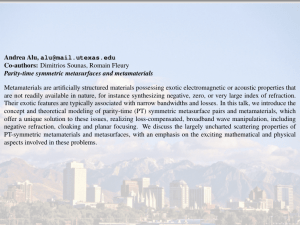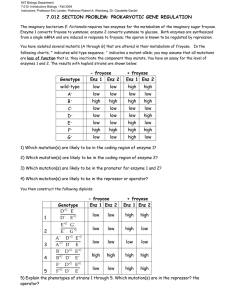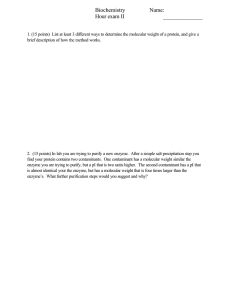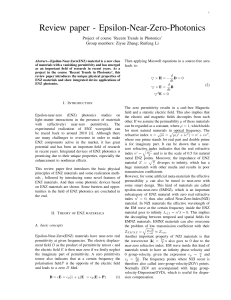1 or - FER
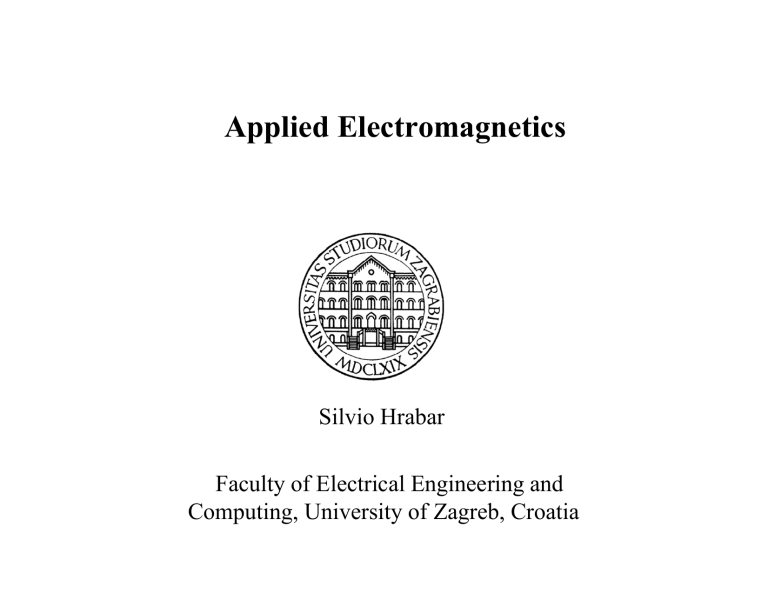
Applied Electromagnetics
Silvio Hrabar
Faculty of Electrical Engineering and
Computing, University of Zagreb, Croatia
The Course Structure
Part I Artificial electromagnetic materials
Part I Metamaterial-based guiding structures
Part III Metamaterial-based antennas and scatterrers
Part IV Active Metamaterials
Part V New directions
Part IV Active Metamaterials
• Why all passive metamaterials are inherently narrowband ? Example – ‘invisibility cloak’
• Is it possible to go around basic dispersion constraints ?
• Novel concept of ultra-broadband active ENZ or
MNZ metamaterials based on non-Foster elements –
Analytical and experimental results
• Conclusions
How to make an object ‘invisible’?
• One should reduce (or ideally completely suppress) scattering …
Transmitting antenna
S inc
Transmitting and receiving antenna
So, suppressing should be done in all possible directions
(cloaking!)
Method I – Cancellation of scattered field by
‘reversed’ scattering (Engheta 2005)
Experimental verification will be reported soon
In order to obtain ‘negative polarizability’ one needs
plasmonic coating ( r
<1) v p
c
In other words, a coating must support propagation of fast waves (v p
>c)
Method II – ‘Transformation Electromagnetics’
(Dollin 1961, Pendry 2006)
Experimental verification already reported r
z
'
'
'
R
1
z
r
(
R
2
R
2
R
1 )
' r
'
' z
'
' r
'
z
( r r
' r r
'
R
2
'
'
R
1
R
1
R
2
R
1
) 2 r ' r '
R
1
Again, a shell (cloak) must support propagation of fast waves (v p
>c)
Method III – Guiding the waves through the object
(Tretyakov et al , 2007)
Experimental verification already reported
A material that supports propagation of fast waves (v p
>c) is not needed but cloaking space is extremely small (< /10)
Thus, it seems that existence of fast waves is necessary for cloaking of moderate or big objects
(all dimensions > /10) that are not narrow and elongated!
Usual (simplified) explanation of cloaking effect v p free space
= c a hidden object an object v p
= c a cloak
v p
>c (either ε
r
<1 or r
<1)
For perfect cloaking EM waves traveling along all different ‘paths’ must experience exactly the same delays (the same phase shifts)!
Influence of the frequency of operation on cloaking v p free space
= c a hidden object an object v p
= c a cloak path i
i
d i
d i k i
c
r
v p
>c (either ε
r
<1 or r
<1)
Inserted phase shift depends both on the frequency and
( , i
) r
( , i
) dispersion properties of used
(meta)material!
r
A or r
Dispersion models of passive materials
(metamaterials) with ε r
<1 or r
<1
Hypothetical dispersionless
1 ENZ (MNZ) material
0
ENG (MNG)
r
B or r
1
0 p
s
Realistic dispersive material
Since the realistic model is highly dispersive one may expect (significant) influence of frequency on MTM operation
E
Resonance is always present in passive metamaterials – WHY? ) dielectric
+
+
-
-
+
+
-
+
-
-
URL: http://www.walterfendt.de/ph14e/resonance.htm
© Walter Fendt, September 9, 1998
Majority of proposed cloak designs are inherently narrowband
Schurig, Pendry at al,
Scienceexpress 2006
BW 0.24%
Ivsic, Sipus, Hrabar, IEEE
Tran. on AP, May 2009.
BW 10%
Silveirinha, Alù, Engheta, Physical
Review E 2007
1.2
1
0.8
0.6
0.4
0.2
What would happen in one had a dispersionless
‘plasmonic’ ( ε r
Example of a cloak with
<1) metamaterial ?
isotropic plasmonic shell i
c
r
( , i
) r
(
1.4
i
d
, i
)
Silveirinha, Alù, Physical Review E
2007
Drude model
No dispersion
0
1 1.1
optimal design frequency
1.2
1.3
Normalized frequency
1.4
1.5
Use of dispersionless plasmonic metamaterial would enable broadband cloaking!
Is it possible to construct passive dispersionless ‘ ( ε r
ENZ metamaterial ?
<1)
The energy within a differential volume of vacuum
W
0
W e
W m
1
2
0
E
2
1
2
0
H
2
The energy within a differential volume of dispersionless material
W
W e
W m
1
2
0
r
E
2
1
2
0
r
H
2
Thus, having dispersionless material with ε r
<1would mean amount of energy that is lower than energy in vacuum!
The energy within a differential volume of dispersive material
W
W e
W m
1
2
0
(
r
)
E
2
1
2
0
( r
)
H
2
Since W>0, it follows that
(
r
)
0 ,
( r
)
0 .
The only way to have ε r
<1 in passive material is to redistribute excess of the energy from the electric field into the magnetic field!
This process is frequency depended, so the existence of dispersionless passive ENZ metamaterial is impossible!
Energy-dispersion constraints lead to Foster theoem!
What is the minimal capacitance of a capacitor that occupies some cubic volume of space ?
l
l
C min
Q
V
0
S
l
0
l
2
l
0
l
S
S
PEC plate
What is the minimal inductance of an inductor that occupies some cubic volume of space ?
l
l
L min
I
0
HdS
JdS
l
0
l
PEC cube
What happens in one redistributes part of the energy from the electric field into the magnetic field (or vice versa) ?
L
l
C
Y
C eff j
C
C
j
1
L
1
2
L
j
1
2
L
0
l
1
2
L
j
C eff
L
l
C
Z
L eff
j
L
L
j
1
C
1
2
C
j
1
0
l
1
2
C
2
C
j
L eff
There are many reports in MTM community that do not take care of these basic constraints!
•IEEE Antennas and Wireless Propagation Letters,
•Vol. 8, pp. 1154 – 1157, November 2009 unit cell
???
The Concept of Artificial Material
( Metamaterial) a host material scatterer (implant)
E
P
• If a
, the structure can be analysed as a homogenous material with some new and metamaterial
• All kinds of passive metamaterials redistribute energy from the electric field into magnetic field (or vice versa)!
MTM with
MTM with
a volume of space occupied with an
MTM inclusion a volume of space occupied with an
MTM inclusion
E excitation
W e
W m H excitation
W m
W e
• Due to this redistribution all passive metamaterials are inherently dispersive!
Example 1 - Wire Medium (Rotman 1962, Pendry 1998)
Z
l
E
Y
P
a r
1
p
2
H
2
E
2
E
j
j
E
x
2
V
ZY V
2
Free-space j
X series
j
Y shunt
V
Wires
0
0
r
<0
0 f<f p
r
<0
0
1 f>f p
0> r
>1
0 a
r
reffz f p
1 real part imaginary part f
l l l
Example 2: Metamaterial Transmission Line
Concept
H
L
E
(Caloz et al. 2002, Iyer et al. 2002, Oliner 2002)
H
forward-wave
propagation
C backward-wave
propagation
C
E L
C
l
l
Extension of the C-L
Backward-wave
Transmission Line to 2D
Case
(Iyer et al. 2002)
Example 3: Wire-loop and capacitivelly loaded loop
(SRR), (Smith 1999, Schelkunoff 1955, Hrabar et al
2003)
Hi r
Hs
R
C
L
E i nc
E s ca t
Z
V=L E ef in Z I
Z
I V=-
in
V
0
j
0
AH i
Z I
R
L C
Lorentz model
µ or
0
1
0 f
0 f mp f
Can one go around the dispersion-energy limitations?
W
W e
W m
1
2
0
(
r
)
E
2
1
2
0
( r
)
H
2
(
r
)
0 ,
( r
)
0 .
???
The only way is to use active medium (i.e. to introduce active elements that do not obey Foster theorem!)
Active medium should introduce ‘assisting negative restoring force’ !
F as
One would need a ‘negative spring’ or a‘negative weight’
•URL: http://www.walterfendt.de/ph14e/resonance.htm
© Walter Fendt, September 9, 1998
jX
• Basic principle of Non-Foster reactive elements (negative C and negative L)
I
X
C
X
L
I I f
V
Z
V
Z
V
0
=2
V
‐ jX
X
C
X
L
Z
A=+2
V
0
=2
Z in
V in
I in
V l
I l
Z l
Classical NIC Designs
How to access the Stability Issue
Use of ordinary stability factors (Rolett, Stern …) can give completely wrong predictions!
•30
How to access the Stability Issue
1 GHz
Unstable!
1 GHz
Unstable!
4 GHz
4 GHz
Use of ordinary stability factors (Rolett, Stern …) can give completely wrong predictions!
•31
C
0
How to access the Stability Issue
u ( t )
CR du
( t
) dt
0 u
( t
) u
( 0 ) e
t
V = 1V
0_
C
0 u ( t )
CR du ( t ) dt u
( t
) u
( 0 ) e
t
RC
0
u
( 0 ) e
R t
C
•32
New idea : Introduction of negative capacitance into
TL (Hrabar et al , APS 2008)
Negative capacitance
Positive capacitance
C
C
1
C
2
C e
C
C
C
C
e
0
0
Negative capacitor is inherently unstable, but overall capacitance
>0 and this circuit is stable !
0 1
2D ENZ Unit Cell for Cloak Design - Experiments
(Hrabar et al, Metamaterial Conference 09)
Microstrip line real imaginary circuitry is located on the ground plane side
air
A circuit simulator (ADS) model of 2D active plasmonic cloak
Air
Dispersionless ENZ
PEC
Total of 89 x 89 (7921 c ells) cloak
C<0
19 c ells
45 c ells
49 c ells
89 c ells
Measurement data are used target
Results of circuit simulation (ADS) of 2D active plasmonic cloak
An ADS model of 2D active plasmonic cloak
(Hrabar et al. , Metamaterials Journal, 2010)
1D Unit Cells in RF Regime
• Fast OPAMP-based (10 MHz -40 MHz)
• MOSFET-based (80 MHz -300MHz)
BF999
Experimental Active ENZ TL with Three Unit Cells
(l = 1 m)
Z
0
Realistic
C
Realistic
C
Realistic
C
x= x= x=
Measurement of effective permittivity of ENZ
Active TL with Three Unit Cells
ENZ switched OFF
ENZ switched ON
Measurement of Phase and Group Velocity of
ENZ Active TL with Three Unit Cells vp vg
Transient Behavior - Measurement in Time Domain
Input Z
0
x=
Realistic
C
x=
Realistic
C
x=
Realistic
C
Output
Input
Measurement in Time Domain
Output ( ENZoff ) Output ( ENZ on )
ENZ behavior achieved within one quarter of a period (2.5 nS)
Further research – Track 1 –
Towards anisotropic MTM
Further research – Track 2 –
Towards “Matched Nihility (MENZ)”
L+L neg
Z
Y
C+C neg
l
0 r
1 ,
Z
0
Z
,
Y
0 r
1 ,
ZY
.
It might be possible to obtain broadband “superluminal” behavior with matching to free space.
Further research – Track 2 –
How to mach MTM to free space? a) Basic idea of TEM line with flared ends, b) Simulated E field distribution inside empty line, c) Simulated E field distribution inside line filled with fictitious continuous ENZ material, d) Simulated E field distribution inside line periodically loaded with negat capacitors
V
I
Development of negative inductance
Z
A=+2
V
0
=2
Further research – Track 3 - Towards Volumetric dispersionless ENZ and MNZ MTM
”
dipole
CN
PP capacitor Input port loop L
N
Input loop Output loop
Negative inductor
Negative capacitors
Further research – Track 4 - Towards
“Frequency independent TL”
• Is it possible to completely exclude the influence of the frequency on the TL behaviour ?
Z
L
1
C
1
Y
-L
2
-C
2
l j
ZY
j
ZY
l
l j
L
1
l
1 j
L
2
l
j
1 j
C
1
l
j
C
2
l
j
L
1
L
2
C
2
C
1
Further research – Track 5 - Towards
“Frequency independent TL”
How to increase the frequency of operation?
Use microelectronic technology !
Would it be possible to build microelectronic version of active non-Foster TL unit cell?
Conclusions
• All passive metamaterials suffer from narrowband operation caused by their dispersive nature
• This drawback can be overcome by use of non-
Foster elements
• It is feasible to obtain a multi-octave bandwidth with stable operation
